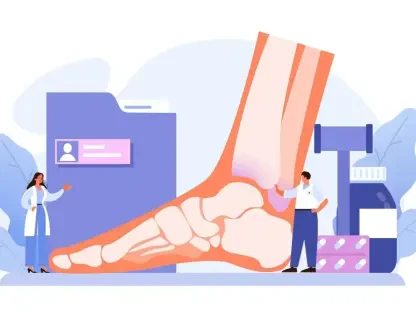The appropriate use of health data is a critical aspect of maintaining patient trust and privacy. As health data becomes increasingly digitized and shared across various platforms, ensuring that it is used for the right purpose is more important than ever. This article explores the essential measures and technologies that can help ensure health data is used appropriately, focusing on the concept of ‘the right purpose.’ The misuse of health data can lead to serious consequences, including identity theft and loss of patient trust, highlighting the necessity of stringent guidelines and advanced technologies to safeguard this sensitive information.
The Importance of Defining the Right Purpose
Building Trust Through Clear Purpose
One of the key elements in managing health data is establishing a clear and enforceable purpose for its use. This is pivotal for building trust in any environment where protected health information (PHI) is exchanged. Without a well-defined purpose, the risk of data misuse increases, leading to potential breaches of patient trust and privacy. By having a clear and enforceable purpose, healthcare providers can ensure that data is used in a manner that aligns with patient expectations, ultimately fostering a trustworthy relationship.
To effectively manage health data, it is essential to codify the purpose of data use, ensuring that all stakeholders understand and adhere to the specified guidelines. This involves setting clear policies and protocols that dictate the appropriate use of data, as well as implementing technologies that can enforce these rules. Ensuring that data is used strictly as intended can help prevent unauthorized access and misuse, thereby safeguarding patient privacy and maintaining trust. The necessity of a clear, enforceable purpose becomes even more apparent when examining real-world examples of data misuse within and beyond the healthcare sector.
Learning from Other Industries
Drawing parallels from other sectors, such as the IRS incident where employees made unauthorized attempts to access taxpayer data, highlights the universal need for strict guidelines governing data use. These examples underscore the importance of having stringent rules in place to prevent unauthorized access and misuse of sensitive information. The IRS case serves as a cautionary tale, demonstrating how lapses in data governance can erode public trust and lead to significant repercussions.
In healthcare, the misuse of patient data can have similarly devastating effects, both for individuals and organizations. By learning from the mistakes and successes of other industries, healthcare providers can develop more robust data governance policies that better protect patient information. The implementation of these policies should be accompanied by regular training and audits to ensure compliance and effectiveness. Establishing a culture of data stewardship, where all members of an organization understand the importance of protecting PHI, is crucial for maintaining patient trust and privacy.
Real-World Examples of Data Misuse
Unauthorized Marketing Practices
Instances of data misuse within the healthcare industry are not uncommon. For example, a hospital system was fined for using patient information from the scheduling process to market elective procedures, a practice not authorized under the patient’s original consent. Such actions violate the trust patients place in healthcare providers and highlight the need for clear consent protocols. This case exemplifies how even well-intentioned uses of data can lead to serious breaches of trust if not properly managed and authorized.
Unauthorized marketing practices serve as a reminder that healthcare providers must be vigilant in ensuring that data is used strictly for the purposes consented to by patients. Implementing robust consent management systems can help mitigate the risk of unauthorized data use. These systems should be designed to clearly communicate the specific purposes for which data will be used, as well as obtain and document patient consent for each specific use. By doing so, healthcare providers can maintain patient trust and comply with regulatory requirements, thereby minimizing the risk of data misuse.
The Cambridge Analytica Scandal
The Cambridge Analytica scandal serves as a stark reminder of the consequences of unauthorized data repurposing. Personal data was used without user consent, leading to severe repercussions such as identity theft and extortion. This case illustrates the devastating implications of data misuse and the necessity for stringent controls on data use. In the healthcare context, similar unauthorized repurposing of patient data could result in equally serious consequences, including financial harm, reputational damage, and loss of trust.
To prevent such scenarios, healthcare organizations must implement robust data governance frameworks that clearly define the permissible uses of patient data. These frameworks should include mechanisms for monitoring and enforcing compliance, as well as procedures for addressing any instances of data misuse. By establishing a strong governance structure and fostering a culture of accountability, healthcare providers can better protect patient data and ensure that it is used ethically and legally. The lessons learned from the Cambridge Analytica scandal should serve as a catalyst for proactive efforts to secure health data and maintain patient trust.
Defining the Right Purpose in Healthcare
Treatment, Payment, and Healthcare Operations (TPO)
In healthcare, defining the “right purpose” for data usage generally falls within categories like treatment, payment, or healthcare operations (TPO) as set by HIPAA. These categories provide a framework for appropriate data use, ensuring that PHI is used in ways that benefit patient care and healthcare operations. By adhering to HIPAA guidelines, healthcare providers can ensure that data is used ethically and legally, while also supporting the efficient functioning of the healthcare system.
However, adhering to HIPAA guidelines alone is not enough. Healthcare providers must also ensure that the specific uses of data within these broad categories are clearly defined and communicated to patients. This includes obtaining explicit consent for each specific use and ensuring that data is only accessed by authorized individuals for authorized purposes. By doing so, healthcare providers can build patient trust and ensure compliance with regulatory requirements, ultimately fostering a more secure and trustworthy healthcare environment.
Navigating Ambiguous Boundaries
When data is used for research, marketing, or quality improvement, the boundaries can become vague. To address this, it is crucial to ensure that data access adheres to three key conditions: specificity, approval, and auditability. The purpose must be narrowly defined, align with regulatory guidelines, and be traceable to ensure transparency and accountability. By implementing these conditions, healthcare providers can ensure that data is used appropriately and ethically, even in scenarios where the boundaries are less clear.
Navigating these ambiguous boundaries requires a combination of clear policies, robust consent management systems, and advanced technologies to monitor and enforce data use. For example, healthcare providers can leverage technologies such as blockchains or distributed ledgers to create immutable records of data transactions, ensuring that data is only used for its intended purposes. Additionally, regular audits and compliance checks can help identify and address any instances of data misuse, further safeguarding patient information and maintaining trust.
Enforcing the Right Purpose with Technology
Traditional Governance Structures
Traditionally, data use policies relied on agreements and governance structures to enforce the right purpose. However, these methods are not foolproof and can be prone to errors. There is a growing need for more robust and reliable methods to ensure data is used appropriately. As the volume and complexity of health data continue to increase, traditional governance structures alone may not be sufficient to manage the associated risks and ensure compliance with regulatory requirements.
To address these challenges, healthcare providers must adopt a more proactive and technology-driven approach to data governance. This involves integrating advanced technologies and automated systems that can monitor and enforce data use policies in real-time. By leveraging these technologies, healthcare providers can enhance their ability to detect and prevent unauthorized data use, ultimately safeguarding patient information and maintaining trust. Traditional governance structures should be complemented with these advanced solutions to create a more comprehensive and effective data governance framework.
Authentic Chained Data Containers (ACDCs)
A technology-driven approach through authentic chained data containers (ACDCs) offers a solution. ACDCs are an open-source protocol that encapsulates health data with embedded permissions, ensuring specific, approved, and auditable purposes are met before data exchange. These cryptographic proofs streamline data use verification and enforcement in healthcare settings. By embedding permissions directly within the data itself, ACDCs provide a practical and efficient method for ensuring that data is only used for its intended purposes.
Implementing ACDCs can help healthcare providers overcome many of the challenges associated with traditional data governance methods. For instance, researchers needing access to patient records for studies would require cryptographic credentials indicating their access is allowed under an institutional review board’s approved research. If the purpose does not match what’s encoded in the ACDC, access is automatically denied, eliminating reliance on traditional and often error-prone access controls. This level of precision and automation can significantly enhance the security and reliability of health data governance, ensuring that data is used ethically and legally.
Addressing Purpose Drift
Role-Based Access Control
Purpose drift, where data gradually begins to be used beyond its originally intended purposes, poses a significant risk. Implementing role-based access control ensures that only those with the proper role and purpose can access data, reducing the likelihood of unauthorized use. This approach involves assigning specific roles to individuals based on their responsibilities and the necessary access to perform their duties, thereby minimizing the risk of data misuse.
By integrating role-based access control with advanced technologies such as ACDCs, healthcare providers can create a more robust and reliable framework for data governance. This combination allows for the precise management of data access based on specific roles, while also providing the ability to monitor and enforce data use policies in real-time. Additionally, regular training and education for staff on the importance of data security and proper access controls can help further reduce the risk of purpose drift and unauthorized data use.
Regular Audits and Clear Consent Protocols
Conducting regular audits can help detect and address purpose violations. These audits can be automated through cryptographic logs, providing a reliable method for monitoring data use. Additionally, ensuring clear and specific patient consent is crucial. Technologies like ACDCs can encode this consent directly within the data, further safeguarding against misuse. By regularly auditing data use and implementing clear consent protocols, healthcare providers can maintain the integrity and trustworthiness of their data governance practices.
Regular audits should be complemented by a strong focus on patient consent management. This involves not only obtaining explicit consent for data use but also ensuring that patients are fully informed about how their data will be used and by whom. Transparent and easily understandable consent forms, along with clear communication about data use policies, can help build patient trust and ensure compliance with regulatory requirements. By combining regular audits with robust consent management practices, healthcare providers can create a more secure and trustworthy environment for managing health data.
The Role of Cryptographic Protocols
Ensuring Transparency and Accountability
Cryptographic protocols such as ACDCs provide a practical, zero-trust method to verify and enforce the purpose of data use in every transaction. By embedding permissions and consent within the data itself, these protocols ensure that data is used ethically and transparently. This level of security and accountability is essential for maintaining patient trust and complying with regulatory requirements. With cryptographic proofs, healthcare providers can provide verifiable evidence of data use compliance, further enhancing trust and confidence in their data governance practices.
Implementing cryptographic protocols can also streamline the process of managing and enforcing data use policies. By automating key aspects of data governance, healthcare providers can reduce the risk of human error and improve the overall efficiency and effectiveness of their data management processes. This not only enhances data security but also supports the broader objectives of improving patient care and healthcare operations. As the volume and complexity of health data continue to grow, the adoption of advanced cryptographic protocols will become increasingly important for ensuring ethical and transparent data use.
Building a Trustworthy Healthcare Environment
Proper use of health data is vital to maintaining patient privacy and trust. With the digitization and sharing of health data across various platforms, it’s more crucial than ever to ensure this data is used correctly. This article delves into the critical measures and advanced technologies necessary to ensure health data serves its intended purpose. Misusing health data can result in severe consequences, such as identity theft and erosion of patient trust, stressing the need for rigorous guidelines and cutting-edge technologies to protect this sensitive information. Stringent regulations and innovative security measures are essential to prevent unauthorized access and misuse. By implementing robust data protection frameworks, healthcare providers can foster a trustworthy environment that upholds patient privacy while enabling the beneficial use of health data. The ongoing challenge lies in balancing accessibility with security, ensuring that health data is utilized ethically and responsibly to advance healthcare outcomes and maintain patient confidence.









